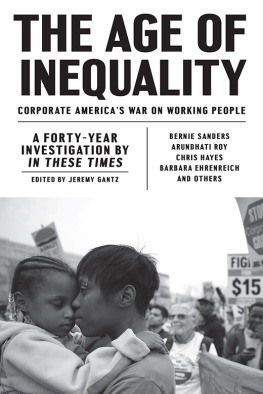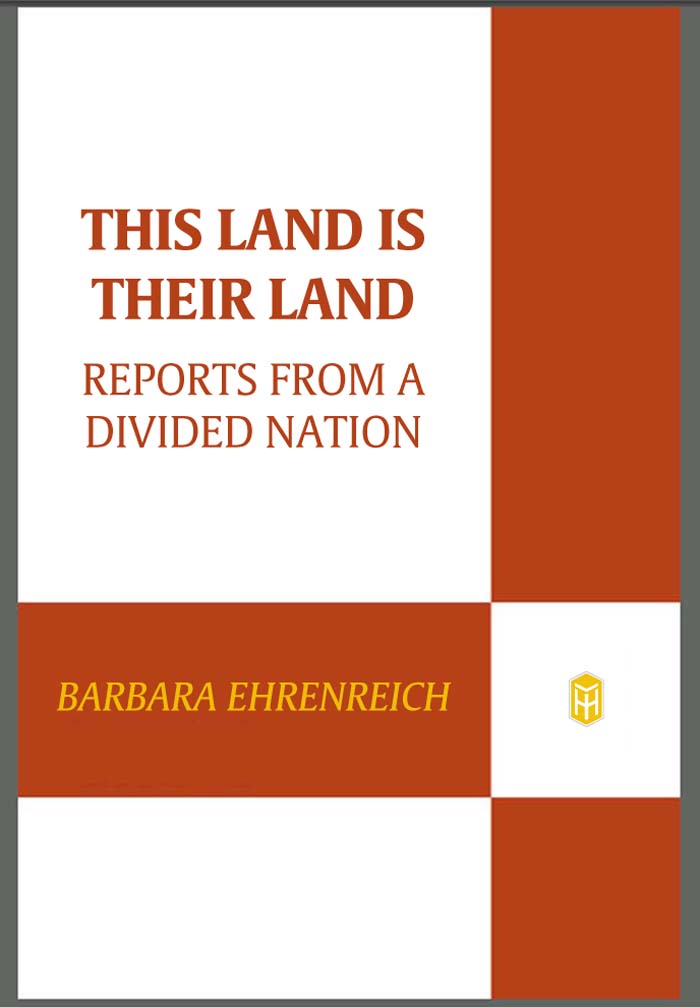Also by Barbara Ehrenreich
Dancing in the Streets: A History of Collective Joy
Bait and Switch: The (Futile) Pursuit of the American Dream
Nickel and Dimed: On (Not) Getting By in America
Blood Rites: Origins and History of the Passions of War
The Snarling Citizen
Kippers Game
The Worst Years of Our Lives:
Irreverent Notes from a Decade of Greed
Fear of Falling: The Inner Life of the Middle Class
The Hearts of Men:
American Dreams and the Flight from Commitment
Global Woman:
Nannies, Maids, and Sex Workers in the New Economy
( WITH A RLIE R USSELL H OCHSCHILD )
Re-making Love: The Feminization of Sex
( WITH E LIZABETH H ESS AND G LORIA J ACOBS )
For Her Own Good: 150 Years of the Experts Advice to Women
( WITH D EIRDRE E NGLISH )
Witches, Midwives, and Nurses: A History of Women Healers
( WITH D EIRDRE E NGLISH )
Complaints and Disorders: The Sexual Politics of Sickness
( WITH D EIRDRE E NGLISH )
The Mean Season: The Attack on the Welfare State
( WITH F RED B LOCK , R ICHARD A. C LOWARD , AND F RANCES F OX P IVEN )
T H I S
L A N D
IS THEIR
L A N D
Barbara
Ehrenreich
T H I S
L A N D
IS THEIR
L A N D
Reports from a Divided Nation

Metropolitan Books
Henry Holt and Company
New York

Metropolitan Books
Henry Holt and Company, LLC
Publishers since 1866
175 Fifth Avenue
New York, New York 10010
www.henryholt.com
Metropolitan Books and  are registered
are registered
trademarks of Henry Holt and Company, LLC.
Copyright 2008 by Barbara Ehrenreich
All rights reserved.
Distributed in Canada by H. B. Fenn and Company Ltd.
Library of Congress Cataloging-in-Publication Data
Ehrenreich, Barbara.
This land is their land : reports from a divided nation /
Barbara Ehrenreich. 1st ed.
p. cm.
Includes index.
ISBN-13: 978-0-8050-8840-3
ISBN-10: 0-8050-8840-7
1. Social problemsUnited States. 2. United StatesSocial conditions. I. Title.
HN 59.2. E 29 2008
973.93dc22
2008003384
Henry Holt books are available for special promotions and
premiums. For details contact: Director, Special Markets.
First Edition 2008
Designed by Meryl Sussman Levavi
Printed in the United States of America
10 9 8 7 6 5 4 3 2 1
To all the under-celebrated people who
make books possible and available
editorial assistants, copy editors,
proofreaders, publicists, print industry
workers, truck drivers, and
bookstore workers.
Contents
Fastest-Growing Jobs of 06:
Are You Handy with Bedpans and Brooms?
T H I S
L A N D
IS THEIR
L A N D
Introduction
F OR A YEAR OR SO AT THE BEGINNING OF THE MILLEN nium, Americans were swept up in a spasm of unity. We hadnt had an enemy scary enough to pull us together since the USSR deconstructed in 1991, and now here was one capable of bringing down the World Trade Center with box cutters, a group that had declared they wanted every one of us dead, from the janitors in our buildings to the CEOs. Transfixed by the jihadists, we wrapped ourselves in flagsflag sweaters, T-shirts, decals, lapel pins, even underwear and bathing suits. United We Stand, proclaimed the bumper stickers, and These Colors Dont Run.
To be sure, this unity was as thin as a starlet after a sojourn at a spa. How were we to express it, for example, other than through our sartorial decisions? We pondered the ubiquitous instruction to report all suspicious persons and activities and that even more enigmatic command from the New York mass transit system: See something, say something. The president advised us to carry on shopping, which we did to the best of our abilities, remaining in a state of dazed puzzlement while the TSA stripped off our shoes and our belts and the government ripped away habeas corpus and all the elementary ingredients of privacy.
But whatever resonated with us about the idea of a homeland and one nation, indivisible was being quietly undercut by a force more powerful than terrorism, more divisive than treason. In a process that had begun in the 1980s and suddenly accelerated in the early 2000s, the ground was shifting under our feet, recarving the American landscape. The peaks of great wealth grew higher, rising up beyond the clouds, while the valleys of poverty sank lower into perpetual shadow. The once broad plateau of the middle class eroded away into a narrow ledge, with the white-knuckled occupants holding on for dear life.
It wasnt just a shift, of course, governed by impersonal geological forces. The rude hand of human intervention could be felt in 2001, when the government gave the airlines a $20 billion post-9/11 bail-out, with nothing for the ninety thousand freshly laid-off airline employees. In another deft upward redistribution of wealth, the administration cut taxes for the wealthiest Americans while cutting back on services and programs, such as financial aid, for everyone else. We had never had a gang in Washington as noisily committed to Christian values, and yet they had managed to stand core biblical teachings on their head.
The results were glaringly visible by 2004, when the Democratic vice presidential candidate announced there were now two Americas. This was almost certainly an undercount. We had divided into two marketsupscale and downscale, Sears and Sakstwo decades earlier, and now these were further subdividing. The middle class, battered by wave after wave of outsourcings and layoffs, scrambled to meet the ever-rising costs of health care, fuel, and college education. The traditional working class, already savaged by deindustrialization, took the low-paying service jobs that were left, trading their hard hats for mops and trays. They crowded grown children and grandchildren into their homes, which they refinanced at usurious rates. They faced speedups at work and cutbacks in pay. When their monthly health insurance premiums exceeded the mortgage or rent, they abandoned the insurance and fell back on Advil.
As for the rich, mere millionaires and the old-money sorts who favor weather-beaten summer homes in Nantucket barely qualified anymore. The upper class split into the merely affluent, who shop at Williams-Sonoma, and the berrich, who had others do their shopping for them, as well as their child raising, bill paying, servant supervising, and party throwing. At the pinnacles of the wealth scale, extravagance reigned on a scale not seen since the late Roman Empire. Freshly fattened CEOs, hedge fund operators, and financiers hired interior decorators for their private jets, slugged back $10,000 martinis at the Algonquin Hotel in Manhattan, and, in one case, staged a $2 million birthday party in Sardinia featuring an ice statue of David urinating vodka.
There was a connection, as most people suspected, between the massive buildup of wealth among the few and the anxiety and desperation of the many. The money that fueled the explosion of gluttony at the top had to come from somewhere or, more specifically, from someone. Since no domestic oil deposits had been discovered, no new seams of uranium or gold, and since the war in Iraq enriched only the military contractors and suppliers, it had to have come from other Americans. In fact, the greatest capitalist innovations of this past decade have been in the realm of squeezing money out of those who have little to spare: taking away workers pensions and benefits to swell profits, offering easy credit on dubious terms, raising insurance premiums and refusing to insure those who might ever make a claim, downsizing workforces to boost share prices, even falsifying time records to avoid paying overtime.
















 are registered
are registered